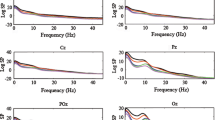Abstract
The characteristics of the temporospatial organization of cerebral cortical potentials at different levels of genetically determined emotionality were analyzed by constructing topograms of instantaneous EEG levels in the inbred rat strains MR and MNRA. Two parameters were calculated for each topogram: the total level and the similarity coefficient. Power spectra were calculated for the values and these were found to change in an oscillatory manner. Interstrain differences were found in the correlated changes in total levels and similarity coefficients, in the durations of changes in the total level, which were more marked than those of similarity coefficients, and the nature of interhemisphere asymmetry. In MR rats, the power spectra of both measures showed significant peaks with modes at 2.0, 6.5, and 9.0 Hz. In MNRA rats, peaks in the spectra of these measures both coincided (2.0 Hz) and differed (7.0 Hz in the spectrum of the total level and 3.0, 4.5, and 6.0 Hz in the spectrum of the similarity coefficient). These data suggest different types of functioning of the reticulothalamocortical and hippocampocortical systems in rats of these strains.
Similar content being viewed by others
References
T. M. Vorob’eva, “The role of the functional interactions of limbic system elements during self-stimulation responses,” Zh. Vyssh. Nerv. Deyat., 19, No. 4, 680–685 (1969).
A. M. Ivanitskii, “Natural science approaches to the question of ‘consciousness and the brain’,” in: First Simonov Lectures [in Russian], Graal’, Moscow (2003), pp. 3–7.
I. N. Knipst, A. V. Korinevskii, and A. I. Yastrebtsev, “Temporal characteristics of the spatial organization of bioelectrical processes during the transmission of excitation in the cortex,” Dokl. Akad. Nauk SSSR, 241, No. 5, 1240–1243 (1978).
I. N. Knipst and E. A. Cheremushkin, “Systems changes in cortical electrical activity and their role in integrative processes in the brain (a synergetic approach),” Usp. Fiziol. Nauk., 32, No. 2, 29–57 (2001).
R. G. Kozhedub, Membrane and Synaptic Modifications of the Basic Principles of Brain Function [in Russian], Éditorial URSS, Moscow (2001).
S. N. Kozhechkin, I.V. Viglinskaya, S. B. Seredenin, N. E. Sviderskaya, T. A. Korol’kova, O. Kh. Koshtoyants, and R. G. Kozhedub, “Effects of the new anxiolytic CM-346 on the bioelectrical activity of the cerebral cortex in Mr and MNRA rats,” Byull. Éksperim. Biol. Med., 128, No. 11, 500–503 (1999).
T. A. Korol’kova, N. E. Sviderskaya, O. Kh. Koshtoyants, S. N. Kozhechkin, R. G. Kozhedub, and E. G. Petukhova, “EEG studies of the anxiolytic effects of scopolamine,” Ros. Fiziol. Zh., 86, No. 5, 588–597 (2000).
N. S. Kurova and S. V. Panyushkina, “Narrowband changes in the EEG spectral composition under the influence of an agonist and an antagonist of the cholinergic neurotransmitter system,” Zh. Vyssh. Nerv. Deyat., 49, No. 2, 352–353 (1999).
E. A. Levin and A. N. Savost’yanov, “Use of methods for evaluating individual alpha rhythm frequencies on analysis of the EEG from humans with different levels of anxiety,” in: Stress and Behavior: Proceedings of the 7th Interdisciplinary Conference on Biological Psychiatry [in Russian], Moscow (2003).
G. M. Molodavkin and T. A. Voronina, “Behavioral and electrophysiological characteristics of mongrel white rats with different emotional reactivities as identified by the forced swimming and conflict situation tests,” in: Stress and Behavior: Proceedings of the 7th Interdisciplinary Conference on Biological Psychiatry [in Russian], Moscow (2003).
L. I. Paikova, “The role of limbic-cortical mechanisms in forming experimental alcoholism in rats,” Zh. Vyssh. Nerv. Deyat., 35, No. 2, 354–362 (1985).
N. E. Sviderskaya, S. B. Seredenin, T. A. Korol’kova, S. N. Kozhechkin, O. Kh. Koshtoyants, and R. G. Kozhedub, “Spatial organization of the EEG in genetically determined emotionality in rats,” Zh. Vyssh. Nerv. Deyat., 50, No. 3, 447–456 (2000).
P. V. Simonov, The Motivated Brain [in Russian], Nauka, Moscow (1987).
S. N. Tsagareli, Functional Asymmetry of the Hippocampus in Rats in the Avoidance Reaction. Relationship Between the Hemispheres of the Brain [in Russian], Metsniereba, Tbilisi (1982), pp. 79–80.
I. A. Yakovenko and E. A. Cheremushkin, “Comparison of rearrangements in the spatiotemporal organization of potentials in the human cerebral cortex with the frequency characteristics of the EEG during solution of cognitive tasks,” Zh. Vyssh. Nerv. Deyat., 46, No. 3, 469–478 (1996).
G. E. Bruder, R. Fong, C. E. Tenke, P. Leite, J. P. Towey, J. E. Stewart, P. J. McGrath, and F. M. Quitkin, “Regional brain asymmetries in major depression with or without an anxiety disorder quantitative electroencephalographic study,” Biol. Psychiatry, 41, No. 9, 939–948 (1997).
P. L. Carlton, “Brain acetylcholine and habituation,” Progr. Brain Res., 28, No. 1, 48–60 (1968).
R. J. Douglas, “The hippocampus and behavior,” Psychol. Bull., 67, No. 6, 416–422 (1967).
J. B. Henriques and R. J. Davidson, “Left frontal hypoactivation in depression,” J. Abnorm. Psychol., 100, No. 4, 535–545 (1991).
R. N. Leaton and M. J. Uttel, “Effects of scopolamine on spontaneous alternation following free and forced trials,” Physiol. Behav., 5, No. 3, 331–334 (1970).
D. Lehmann, H. Ozaki, and J. Pal, “EEG-alpha map series brain microstates by space-oriented adaptive segmentation,” EEG Clin. Neurophysiol., 67, No. 3, 271–288 (1987).
C. Michel and D. Lehmann, “Single doses of pirazetam affect ERP microstate during cognitive information,” Neuropsychobiology, 28, No. 4, 212–221 (1993).
P. P. Pompre and E. Miliaresis, “A comparison of the excitability cycles of the hypothalamic fibres in self-stimulation and exploration,” Physiol. Behav., 24, No. 5, 995–998 (1980).
J. Semmes, “Hemispheric specialization: a possible clue to mechanism,” Neuropsychologia, 6, 11–18 (1968).
J. Yamamoto, “Relationship between hippocampal theta-wave frequency and emotional behavior in rabbits produced with stresses or psychotropic drugs,” Jap. J. Pharmacol., 76, No. 1, 125–127 (1998).
Author information
Authors and Affiliations
Additional information
__________
Translated from Zhurnal Vysshei Nervnoi Deyatel’nosti imeni I. P. Pavlova, vol. 55, No. 4, pp. 518–526, July–August, 2005.
Rights and permissions
About this article
Cite this article
Kozhedub, R.G., Cheremushkin, E.A., Sviderskaya, N.E. et al. Emotionality and the temporospatial organization of instantaneous EEG potentials. Neurosci Behav Physiol 36, 663–670 (2006). https://doi.org/10.1007/s11055-006-0071-3
Received:
Accepted:
Issue Date:
DOI: https://doi.org/10.1007/s11055-006-0071-3



